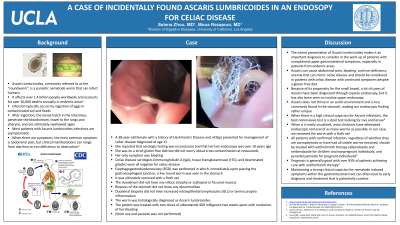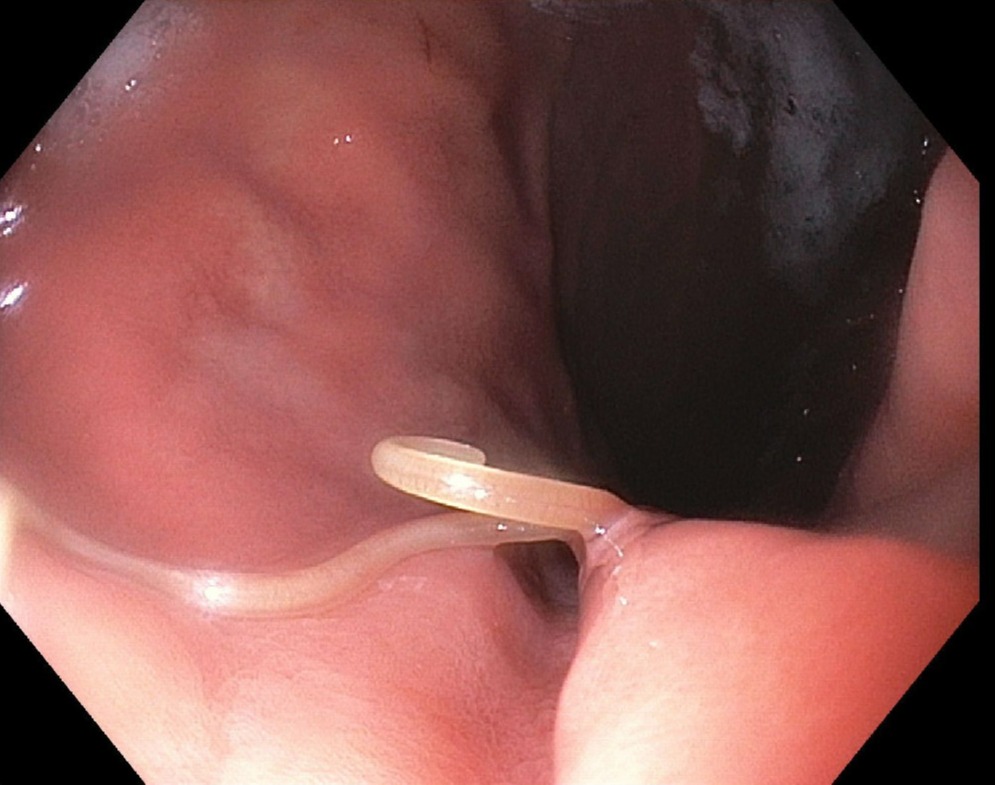Sunday Poster Session
Category: General Endoscopy
P0578 - A Case of Incidentally Found Ascaris lumbricoides in an Endoscopy for Celiac Disease
Sunday, October 22, 2023
3:30 PM - 7:00 PM PT
Location: Exhibit Hall

Has Audio
.jpg)
Selena Zhou, MD
UCLA
Los Angeles, CA
Presenting Author(s)
Selena Zhou, MD, Mona Rezapour, MD, MHS
UCLA, Los Angeles, CA
Introduction: Ascaris lumbricoides is a parasitic nematode worm that can infect humans. Endemic in much of the less developed world, it has been estimated to affect over one quarter of the world’s population. Infection typically occurs by ingestion of eggs in contaminated soil and foods. Ascaris has been reported all along the gastrointestinal tract, including the esophagus, stomach, small bowel, and biliary system. Here we report a case of incidentally found Ascaris lumbricoides during upper GI endoscopy for celiac disease surveillance.
Case Description/Methods: A 38-year-old female with a history of Hashimoto’s Disease and vitiligo presented for management of celiac disease diagnosed at age 12. She reported that serologic testing was inconclusive and that her last endoscopy was over 10 years ago. Her only symptom was bloating. She was on a strict gluten free diet. She did not have any abnormalities in her blood work, including no iron deficiency anemia. Celiac disease serologies were ordered as well as an esophagogastroduodenoscopy (EGD). Her serologic markers were all negative for celiac disease. A month prior to the EGD, she reintroduced gluten to her diet with no changes in her symptoms. Four days prior to her EGD, she had sushi. EGD was then performed in which, immediately upon passing the gastroesophageal junction, a live round worm was seen in the stomach. It was ultimately removed with a Roth net. The EGD was otherwise normal. The duodenum did not have any villous atrophy or scalloped or fissured mucosa. Duodenal biopsies did not have increased intraepithelial lymphocytes (IELs) or lamina propria inflammation. Biopsies of the stomach did not show any abnormalities. The worm was histologically diagnosed as Ascaris lumbricodes. The patient was treated with two doses of Albendazole two weeks apart with resolution of bloating.
Discussion: The clinical manifestations of Ascaris lumbricodes infections can range from asymptomatic to absorption issues to frank obstruction. This varied presentation makes it an important diagnosis to consider in the work up of patients with unexplained GI symptoms. When Ascaris is seen endoscopically, endoscopic removal of as many of the worms as possible should be attempted. Patients should then be treated with antihelminth therapy. Ultimately, in developed countries, nematode induced symptoms within the gastrointestinal tract are not a common diagnosis. A high clinical suspicion can often lead to early diagnosis and treatment that is potentially curative.

Disclosures:
Selena Zhou, MD, Mona Rezapour, MD, MHS. P0578 - A Case of Incidentally Found Ascaris lumbricoides in an Endoscopy for Celiac Disease, ACG 2023 Annual Scientific Meeting Abstracts. Vancouver, BC, Canada: American College of Gastroenterology.
UCLA, Los Angeles, CA
Introduction: Ascaris lumbricoides is a parasitic nematode worm that can infect humans. Endemic in much of the less developed world, it has been estimated to affect over one quarter of the world’s population. Infection typically occurs by ingestion of eggs in contaminated soil and foods. Ascaris has been reported all along the gastrointestinal tract, including the esophagus, stomach, small bowel, and biliary system. Here we report a case of incidentally found Ascaris lumbricoides during upper GI endoscopy for celiac disease surveillance.
Case Description/Methods: A 38-year-old female with a history of Hashimoto’s Disease and vitiligo presented for management of celiac disease diagnosed at age 12. She reported that serologic testing was inconclusive and that her last endoscopy was over 10 years ago. Her only symptom was bloating. She was on a strict gluten free diet. She did not have any abnormalities in her blood work, including no iron deficiency anemia. Celiac disease serologies were ordered as well as an esophagogastroduodenoscopy (EGD). Her serologic markers were all negative for celiac disease. A month prior to the EGD, she reintroduced gluten to her diet with no changes in her symptoms. Four days prior to her EGD, she had sushi. EGD was then performed in which, immediately upon passing the gastroesophageal junction, a live round worm was seen in the stomach. It was ultimately removed with a Roth net. The EGD was otherwise normal. The duodenum did not have any villous atrophy or scalloped or fissured mucosa. Duodenal biopsies did not have increased intraepithelial lymphocytes (IELs) or lamina propria inflammation. Biopsies of the stomach did not show any abnormalities. The worm was histologically diagnosed as Ascaris lumbricodes. The patient was treated with two doses of Albendazole two weeks apart with resolution of bloating.
Discussion: The clinical manifestations of Ascaris lumbricodes infections can range from asymptomatic to absorption issues to frank obstruction. This varied presentation makes it an important diagnosis to consider in the work up of patients with unexplained GI symptoms. When Ascaris is seen endoscopically, endoscopic removal of as many of the worms as possible should be attempted. Patients should then be treated with antihelminth therapy. Ultimately, in developed countries, nematode induced symptoms within the gastrointestinal tract are not a common diagnosis. A high clinical suspicion can often lead to early diagnosis and treatment that is potentially curative.

Figure: Ascaris lumbricoides in the stomach on upper endoscopy.
Disclosures:
Selena Zhou indicated no relevant financial relationships.
Mona Rezapour: Abbvie – Speakers Bureau. BMS – Advisory Committee/Board Member. Eli lilly – Advisory Committee/Board Member. Janssen – Speakers Bureau.
Selena Zhou, MD, Mona Rezapour, MD, MHS. P0578 - A Case of Incidentally Found Ascaris lumbricoides in an Endoscopy for Celiac Disease, ACG 2023 Annual Scientific Meeting Abstracts. Vancouver, BC, Canada: American College of Gastroenterology.
